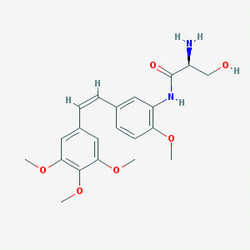| Cas No.: | 181816-48-8 |
| Chemical Name: | (2S)-2-amino-3-hydroxy-N-[2-methoxy-5-[(Z)-2-(3,4,5-trimethoxyphenyl)ethenyl]phenyl]propanamide |
| Synonyms: | AVE8062; AVE8062A; AC7700; AVE-8062; AVE-8062A; AC-7700; AVE 8062; AVE 8062A; AC 7700 |
| SMILES: | COC1=C(C=C(C=C1)/C=C\C2=CC(=C(C(=C2)OC)OC)OC)NC(=O)[C@H](CO)N |
| Formula: | C21H26N2O6 |
| M.Wt: | 402.44 |
| Purity: | >98% |
| Sotrage: | 2 years -20°C Powder, 2 weeks 4°C in DMSO, 6 months -80°C in DMSO |
| Description: | Ombrabulin is a derivative of CA-4 phosphate, which is known to exhibit antivascular effects through selective disruption of the tubulin cytoskeleton of endothelial cells. |
| Target: | tubulin[1] |
| In Vivo: | Before performing therapy experiments, the tolerability of various doses of Ombrabulin (AVE8062) ranging from 10 to 100 mg/kg is tested given twice weekly via i.v., i.p., or s.c. routes in nude mice (n=3 per group). The i.v. and s.c. routes are not pursued further due to problems with skin or tail vein necrosis. The i.p. route is well tolerated with doses up to 100 mg/kg. Next, preliminary experiments are done to determine the lowest dose for in vivo therapeutic efficacy. Starting 7 days after tumor cell injection, nude mice (n=5 per group) bearing HeyA8 ovarian cancer cells are treated with either vehicle or Ombrabulin 10, 30, 50, and 100 mg/kg twice weekly i.p. for 3 weeks. There is 65% reduction in tumor weight in the 30 mg/kg group compared with the vehicle control group (P<0.02). The 10 mg/kg dose is not effective. The antitumor effects at doses >30 mg/kg are not significantly better; therefore, the 30 mg/kg dose is selected for subsequent therapy experiments[1]. |
| In Vitro: | The effect of Ombrabulin (AVE8062) on endothelial or tumor cell viability is examined using the MTT assay. The IC50 of Ombrabulin for the mouse mesenteric endothelial cells (MMEC) is 10 nM and ranges between 7 and 20 nM for the tumor cell lines (HeyA8, SKOV3ip1, and HeyA8-MDR). Comparative analysis of the nonlinear least-squares regression of the dose-response curves for each agent alone and combination Ombrabulin /Docetaxel show a significantly lower IC50 than either agent alone (P<0.005, all cell lines). The cytotoxicity of Docetaxel is 2- to 4-fold greater in combination with Ombrabulin for the endothelial and tumor cells compared with Docetaxel alone[1]. |
| Cell Assay: | The capacity of Ombrabulin (AVE8062) to modulate MMEC and HeyA8 cell cycle as well as apoptosis is analyzed by flow cytometry. In all assays, 3×106 tumor cells are seeded into Petri dishes and allowed to adhere overnight. The cultures are then washed with PBS and treated with regular medium (negative control) or medium containing Docetaxel, Ombrabulin (HeyA8, 20 nM; MMEC 10 nM), or Ombrabulin plus Docetaxel. For cell cycle analyses, tumor cells are collected by trypsinization and pooled with the cells floating in the medium. The cell suspensions are centrifuged for 5 min at 1,500 rpm at room temperature, then washed and fixed with ethanol. For apoptosis analysis, cells are incubated overnight in 50 μL of DNA labeling solution (10 μL of reaction buffer, 0.75 μL of TdT enzyme, 8 μL of FITC-dUTP, and 32.25 μL of distilled water) at room temperature. Following the addition of rinse buffer, samples are centrifuged, washed, and fixed in ethanol. All samples are then washed with PBS, then resuspended in propidium iodide (50 μg/mL) and RNase A (20 μg/mL) in PBS for 30 min at room temperature. Stained cells are analyzed on an EPICS XL flow cytometer. The low-level gate is set at the base of the G1 peak and the percentages of cells within the G1 and G2-M phases of the cell cycle are determined by analysis with Multicycle[1]. |
| Animal Administration: | Mice[1] Female athymic nude mice (6-8 weeks old) are used. For in vivo injection, tumor cells are trypsinized, centrifuged at 1,000 rpm ×7 min at 4°C, washed twice, and resuspended in serum-free HBSS at a concentration of 5×106 cells/mL (SKOV3ip1 and HeyA8-MDR) and 1.25×106 cells/mL (HeyA8). Tumors are established by i.p. injection of cells. Ombrabulin therapy is initiated 7 or 17 days after cell line injection. Mice (n=10 per group) are randomly assigned to the following treatment groups: (a) PBS 200 μL, i.p. weekly; (b) Ombrabulin 30 mg/kg [dissolved in PBS (pH 5)] i.p. twice weekly; (c) Docetaxel 2 mg/kg (HeyA8 and HeyA8-MDR) or 1.4 mg/kg (SKOV3ip1) i.p. weekly; (d) Ombrabulin plus Docetaxel (both drugs given at the doses and frequency described above for each drug alone). The dose of Ombrabulin used in these experiments is optimized from dose-escalation studies against tumor growth. Mice are monitored for signs of adverse effects and tumors are harvested after treatment (range 2-5 weeks). The mouse weight, tumor weight, number of tumor nodules, and volume of ascites are recorded at necropsy. |
| References: | [1]. Kim TJ, et al. Antitumor and antivascular effects of AVE8062 in ovarian carcinoma. Cancer Res. 2007 Oct 1;67(19):9337-45. |

 DC Chemicals' products qualify for U.S. tariff exemptions. We guarantee no price increases due to customs duties and maintain stable supply, continuing to deliver reliable research solutions to our American clients.
DC Chemicals' products qualify for U.S. tariff exemptions. We guarantee no price increases due to customs duties and maintain stable supply, continuing to deliver reliable research solutions to our American clients.





















